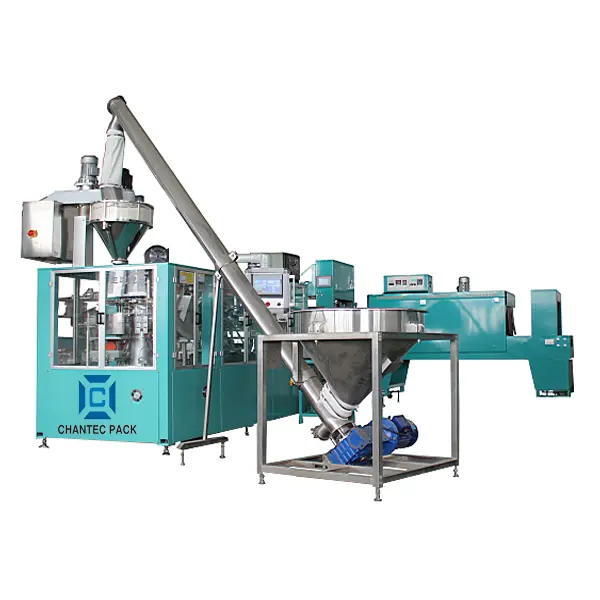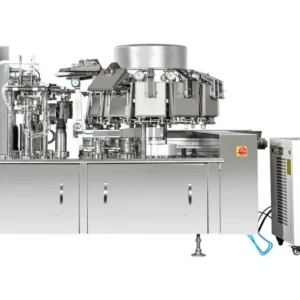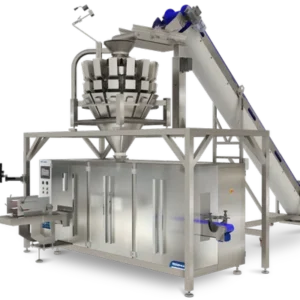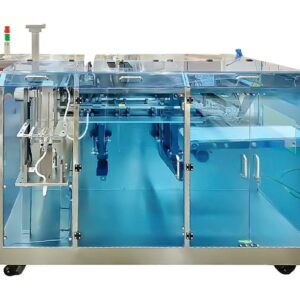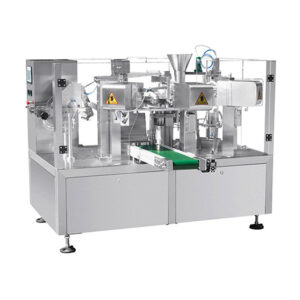Description
| Parameter | Specification |
|---|---|
| Machine Model | APBPL-2000 |
| Bag Types Supported | Multi-layer paper bags |
| Bag Dimensions | Width: 100mm – 400mm<br> Length: 200mm – 600mm |
| Speed | Up to 25 bags per minute (depending on bag size) |
| Power Supply | 380V/50Hz, 3 phase |
| Power Consumption | 7 kW |
| Air Pressure | 0.6 MPa (87 psi) |
| Air Consumption | 0.8 m³/min (28 CFM) |
| Machine Weight | 2000 kg |
| Machine Dimensions (LxWxH) | 3500mm x 1800mm x 2200mm |
| Material | Stainless Steel 304 |
| Control System | PLC (Programmable Logic Controller) |
| Touchscreen Interface | 15-inch color touchscreen |
| Bag Filling Method | Auger filling |
| Sealing Type | Heat sealing |
| Packaging Material | Multi-layer kraft paper |
| Safety Features | Emergency stop button, safety sensors, guardrails |
| Optional Features | Date coding, nitrogen flushing, dust extraction, etc. |
An Induction to Automatic Paper Bag Packaging Line for Flour
The automated paper bag packaging line for flour is a complex system built to streamline the wrapping process while ensuring precision, uniformity, and cleanliness. This automated answer is specifically tailored for the flour industry where it meets special requirements of handling and packing powdered substances.
Packing Processes
The packing process starts with receiving bulk flour in the factory. They then transport it to the packaging line which goes through several stages as follows:
Weighing and Dispensing: The individual bags must be weighed correctly and filled with flour.
Bag Formation: High-quality paper rolls are used in this case, ensuring that they last longer.
Filling: The flour gets accurately deposited into formed bags through mechanisms that regulate its flow and prevent spillage.
Sealing: After filling, heat or adhesives are applied on top of the bags. This is important for product integrity.
Coding And Labeling: Each bag has a code indicating batch number, expiry date, and product specifications among other details written on it.
Palletizing: Such filled and sealed bags are arranged systematically onto pallets ready for storage or transportation.
In all these instances though automation is instrumental in enhancing efficiency while minimizing human error.
Applications
Automatic paper bag packaging lines for flour can be applied widely in different sectors including:
Food Industry: Flour constitutes one of the most essential ingredients in the food sector, especially baking, confectionery, pasta production, etc…It is, therefore, vital to use automatic packing lines when dealing with commercial purposes such as industrial usage.
Retail: Packaged flours are sold by retailers at their outlets such as supermarkets or grocery stores. They therefore need automated packaging lines that produce consumer-ready packs quickly and consistently to satisfy retail demand pressures fully.
Exporting: Usually, there is the exportation of flour across countries’ boundaries. These automatic packaging lines on one hand increase compliance with pack regulations making exportation easier.
Functions of Automatic Paper Bag Packaging Line
The automatic paper bag packaging line for flour has many functions to hasten the packaging process such as:
Weighing and Dispensing: This is important in maintaining consistent pack weights which enhance customer satisfaction and compliance with regulatory standards.
Bag Formation: The seamless formation of high-quality paper bags reduces waste and ensures that products get to their destination without damage.
Filling Control: Flour quantities are precisely regulated to avoid any wastage or product loss, ensuring optimization of its use and lessening of wastage.
Sealing: It also keeps the product fresh through secure sealing mechanisms which prevent moisture or contaminants from getting in thus extending the shelf life of packaged flour.
Coding And Labeling: For example, automated coding and labeling systems enable traceability and enhanced inventory management. These aspects improve the visibility and control over a given product.
Palletizing: The process involves automation to reduce manual handling as well as improve safety within the working environment while reducing risks that occur at work workplace for instance injuries resulting from lifting heavy objects manually.
Sustainability: Paper bags, being biodegradable and recyclable, provide an eco-friendly packaging option that aligns with sustainability goals.
Market Competitiveness: Investing in automated packaging technology enhances competitiveness through faster response to market demands as well as ensuring product consistency and reliability.
Roles and Advantages
Automatic paper bag packaging line plays different key roles in the flour packaging process which gives it an advantage at various stages:
Weighing and Dispensing: Precise weighing guarantees adherence to regulatory standards as well as customer expectations hence avoiding underfilling or overfilling of bags.
Bag Formation: Continuous bag formation helps optimize material usage reducing cost, waste as well as possible downtime.
Filling Control: Accurate filling mechanisms mean consistent pack weights and high-quality end products thus minimizing give-away losses and maximizing profits.
Sealing: Reliable sealing mechanisms maintain product freshness while extending shelf life thereby decreasing chances of spoilage.
Coding and Labeling: Automated coding and labeling systems provide for traceability while meeting regulatory requirements therefore enhancing consumer confidence in the safety of the products.
Palletizing: An automated palletizing system makes handling packed flour easier by saving space hence optimizing warehousing space and improving logistics efficiency.
FAQs
What is the capacity of an automatic paper bag packaging line for flour?
Different models of these packing lines have different capacities which also depend on their configuration. However, many present-day systems are capable of producing a wide range of manufacturing volumes from small-scale operations to large industrial plants.
Can automatic packaging lines be customized for different bag sizes and types of flour?
Indeed, automatic packaging lines can be tailored to suit different sizes of bags, depending on the kind of flour involved during production. The ease with which they can be modified means that customers do not find it difficult to have their needs met whenever there is a need, especially through sectional designs meant for conveying materials used by retailers when they sell items.
How does automation improve packaging efficiency and consistency?
Through automation, the need for manual intervention is eliminated thus reducing errors and inconsistencies in the packaging process. Automated systems ensure precise weighing, filling, sealing, and labeling that yields uniform pack weights as well as product quality.
Are paper bags environmentally sustainable?
Undoubtedly, paper bags are biodegradable and recyclable packaging material which makes them eco-friendly. The use of paper bags by manufacturers reduces the environmental footprint hence making it part of the sustainability concerns.
What are the maintenance requirements for automatic packaging lines?
For optimum performance and life expectancy purposes, regular maintenance other than replacement due to wear out should be carried out on automatic packaging lines. This helps avoid unnecessary downtimes during production as a result of routine inspections; lubrication or worn-out spares having to be replaced.
Can automatic packaging lines handle other types of products besides flour?
Yes, you can alter these machines to accommodate several powdered products such as sugar, salt rice, or various spices among others. Since they are flexible enough to serve different industries and markets, they will be found useful concerning their adaptability within different sectors.
How do automatic packaging lines contribute to food safety?
To guarantee this sanitary aspects have been addressed by making sure that there is no contact between man and machine while proper sealing is done through closed-loop systems that prevent contamination. In addition, these systems minimize the chances of someone coming into contact with the packed food hence improving compliance with standards set by authorities regarding safety measures for such kinds of goods.
What is the return on investment (ROI) for investing in an automatic packaging line?
The ROI of an automatic packaging line is determined by several factors including initial capital expenditure, throughput levels of manpower reductions as well efficiency gains. As evidenced over time increased productivity along with cost savings have led to many manufacturers experiencing improved profitability attributable to this aspect alone.
Can automatic packaging lines be integrated with other production systems?
Yes, one can seamlessly integrate automatic packaging lines with other production systems such as filling, mixing, and conveying systems to create a fully automated production line. This improves efficiency, uniformity, and overall performance of the manufacturing process.
How safe are automatic packaging lines?
Safety features in automatic packaging lines include emergency stop buttons, protective guards, and sensors that ensure operator safety and prevent accidents. Advanced systems also employ machine vision and artificial intelligence (AI) technologies for real-time monitoring as well as anomaly detection.

